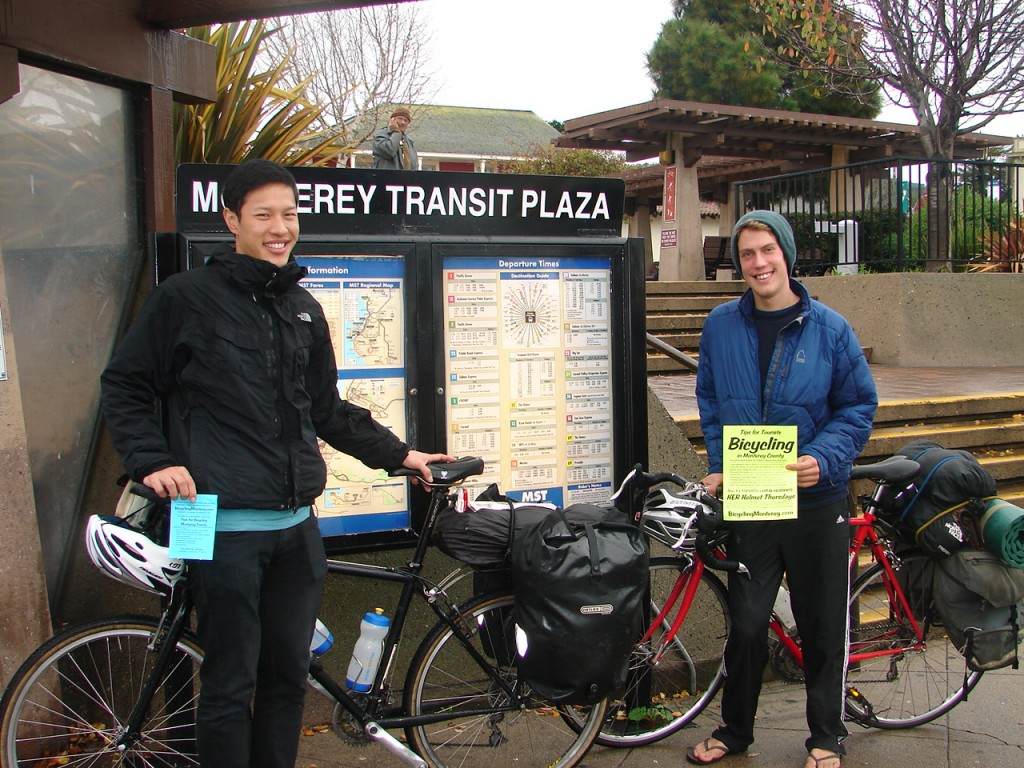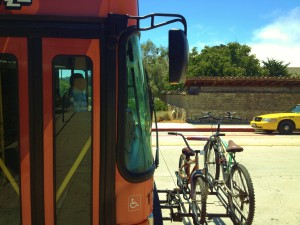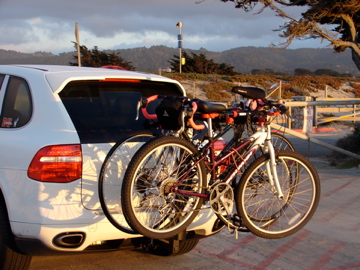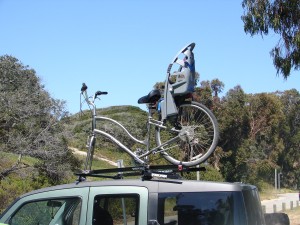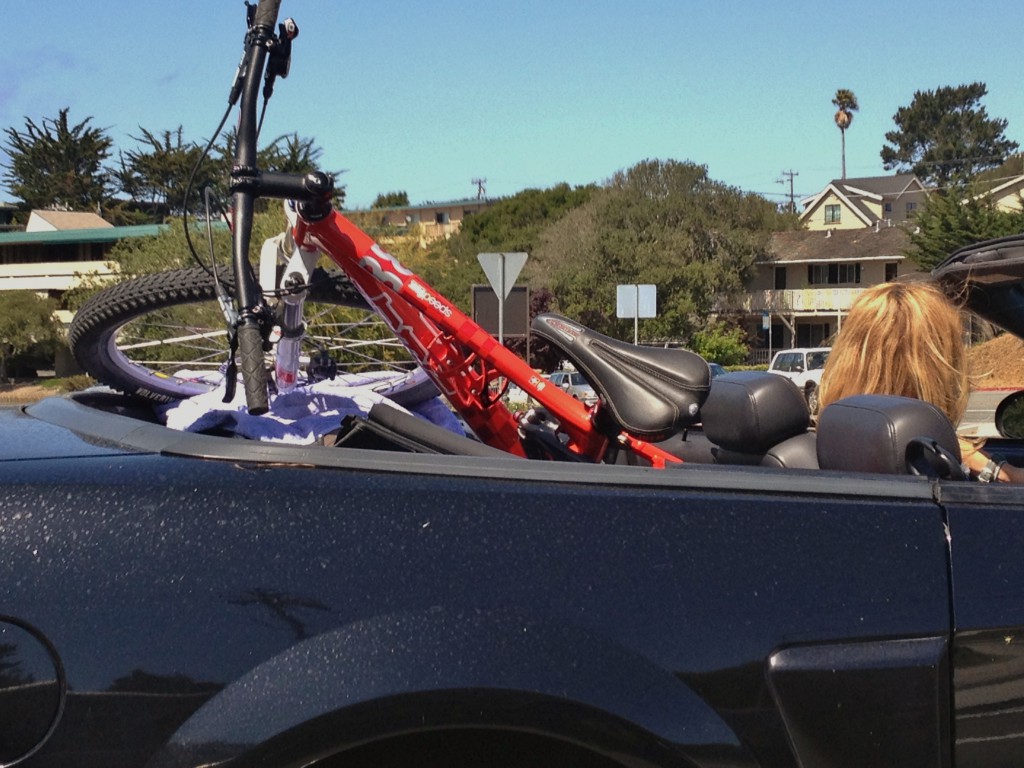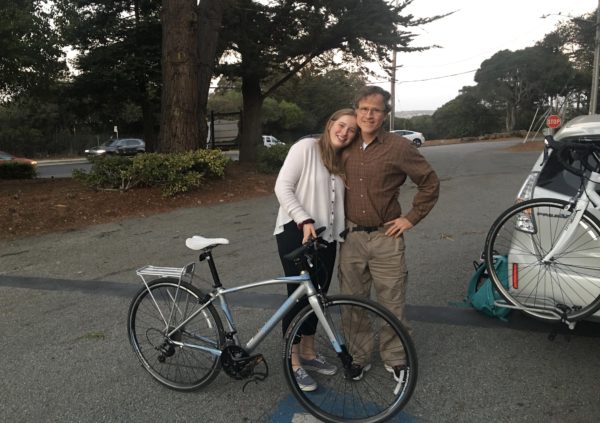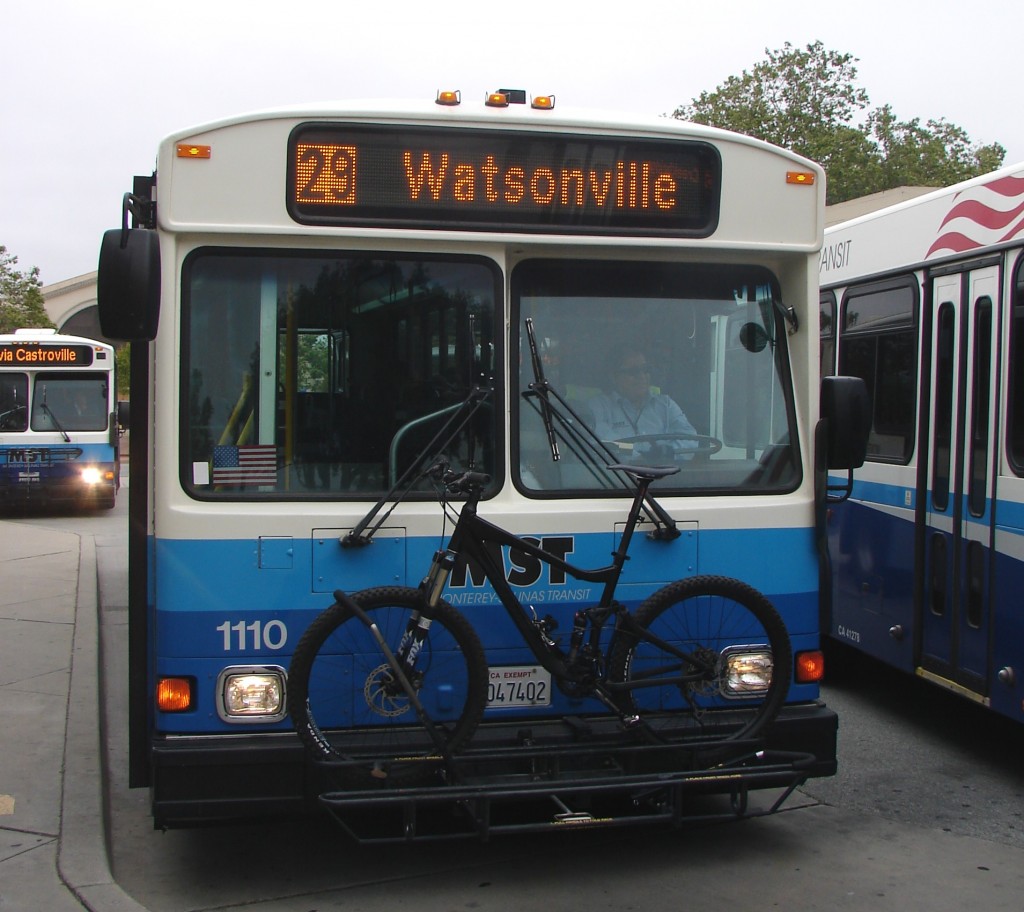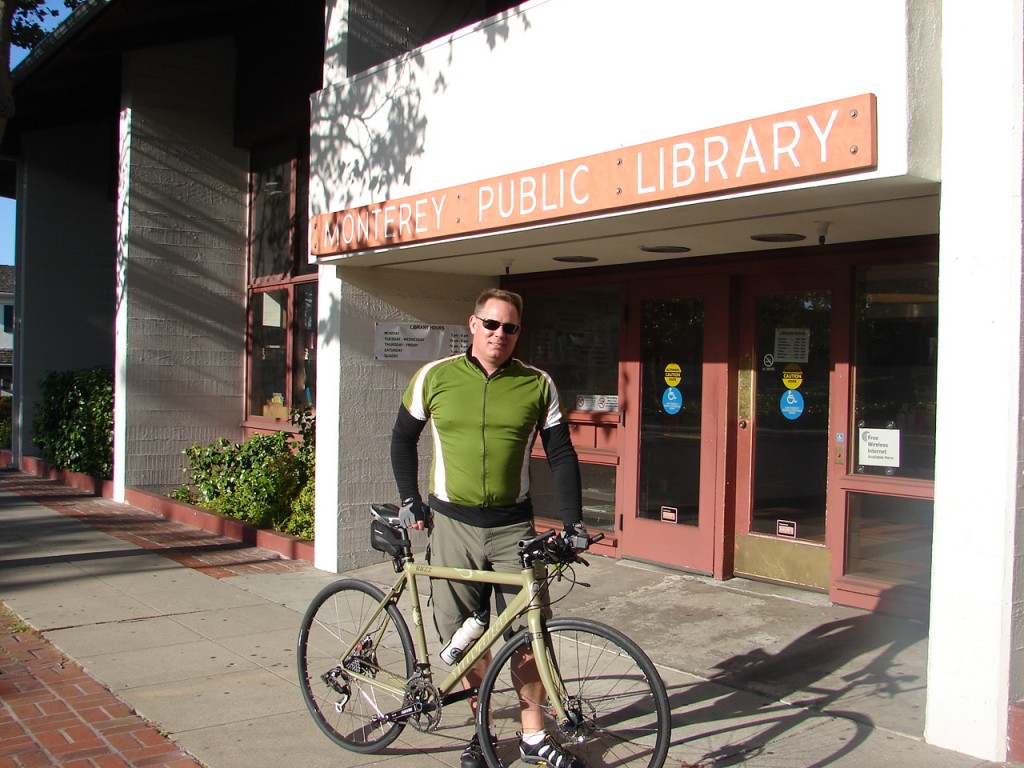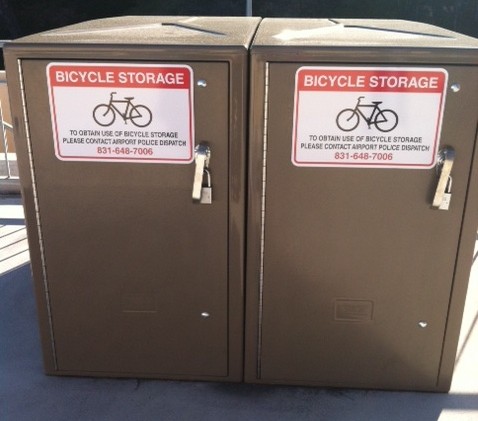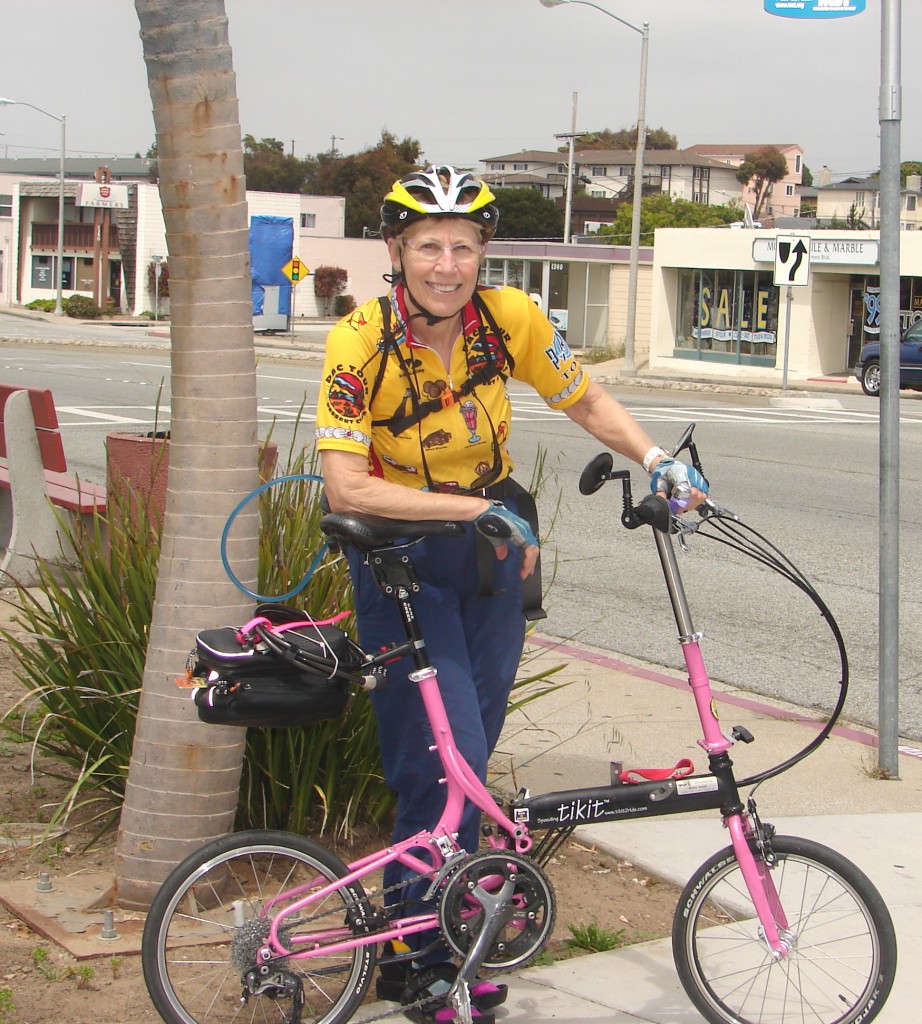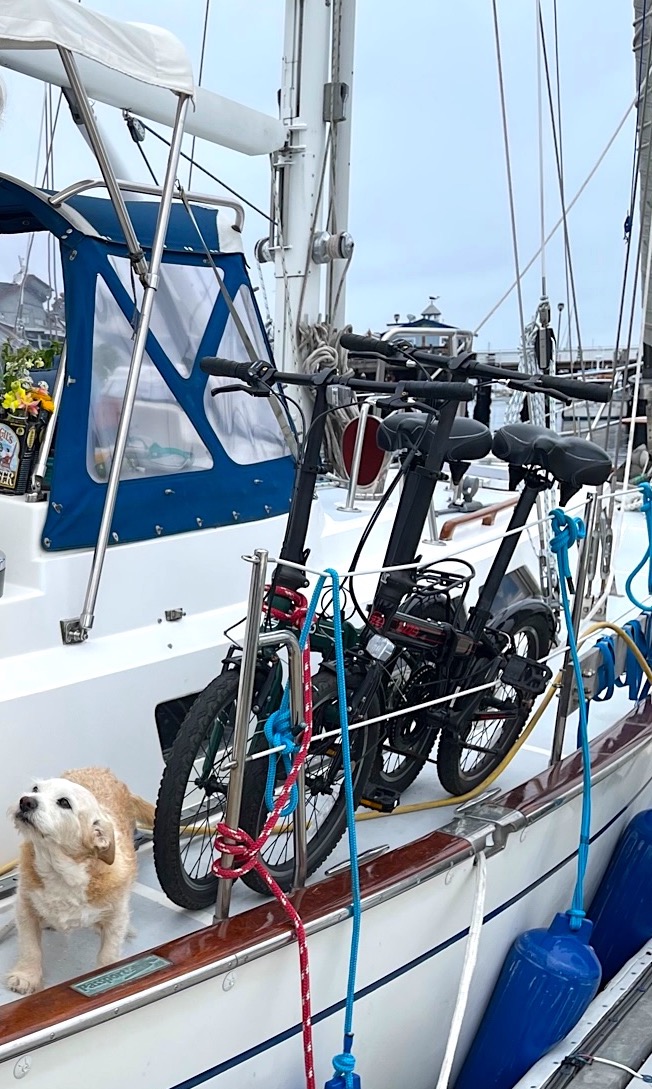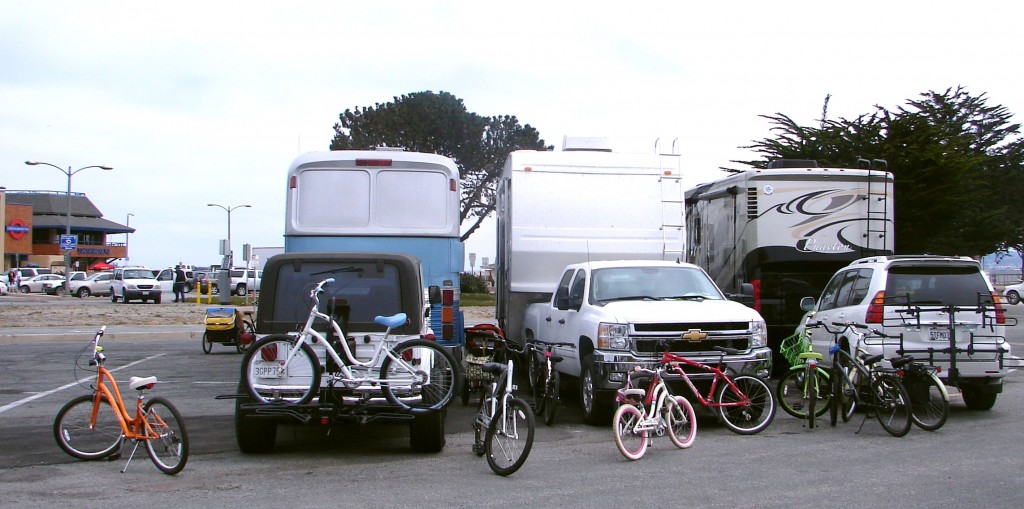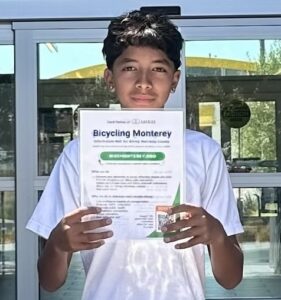5. Bike-and-Ride Options: Bicycling Needn’t Be All or Nothing!
This guide, provided as a public service, was first published in 2009, with many subsequent updates. For additional updates, or if you have questions, please contact us. To return to the portal page of the Tips for Bicycling Monterey County 20-section guide, click here.
Why bike-and-ride?
Any mile of biking beats a mile of driving!
No bicycle? See “Bike Rentals” or “Local Bike Shops–New and Used Purchases.“
A Cyclist’s Transportation Friends, In Fair or Foul Weather
This page offers tips on each of these bike-and-ride options:
-
A bike rack for your car (quickly removable type or more permanently installed)
-
Monterey-Salinas Transit system (MST) – including transit connections.
-
Train (train, train-bus combo system, and transit connections to trains)
-
Taxicabs
-
Hotel shuttles
-
Airport shuttle/Monterey Airbus (connects with airports in other cities; also see “Monterey Regional Airport” below for our local airport tips)
-
Monterey Regional Airport
-
Rental cars
-
Sailboats
While beautiful Monterey County doesn’t have the mass transit systems you’ll find in larger cities, there are some terrific options serving the Monterey Bay region. And these are absolutely getting more bike friendly all the time!
Find helpful info on this website? To contribute, and for FAQs, click here. Thank you.
Now on with bike-and-ride tips!
Derrick Chao and Kyle Ingebretson of the San Francisco Bay Area at the Monterey-Salinas Transit (MST) downtown Monterey Transit Plaza. There are bike racks on all MST buses, with the exception of the ADA (disabilities) buses. Below, learn much more about using MST, including what to do if the bike rack is full.
Special tip for those who live or work in Monterey County: Emergency Ride Home
If you want to bike-and-ride or bike commute to work but hesitate because of concerns about the unexpected–such as unplanned need to work late, sudden illness, or bicycle break-down (more than two miles from home)–hesitate no longer!
If you use the Monterey Salinas Transit system (MST bus) or other alternative transportation, such as your bicycle, even one day a week, you can get reimbursed for taxicab or rental car fee if the unexpected occurs. How? Through the Transportation Agency for Monterey County’s Emergency Ride Home program. Check it out: https://www.tamcmonterey.org/emergency-ride-home.
All or nothing?
Please don’t feel like a wimp! Better to use an occasional “transportation helper,” when you or others in your party prefer to, rather than not to bike at all.
And the more you bike, the more you’ll surely love it. For those who don’t bike much yet, these options can really help you make a breakthrough and see anew all the different ways to incorporate bicycling into your life.
Even when the weather and all conditions are perfect, bike-and-ride options can be just the thing for some trips. Keep reading this section for details on the various alternatives. But first, consider some of those times when a bike-and-ride can be helpful.
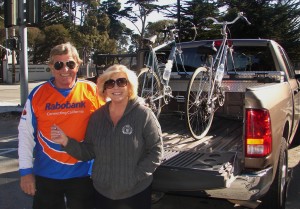
Why bike-and-ride? Here are 10 good reasons!
Besides weather changes (more on weather below), bike-and-ride options allow you to:
- Attend crowded events and zip past traffic jams, plus get nearby parking that is free or low-cost: Ever go to a special event like the Monterey Jazz Festival and feel frustrated about sitting in traffic and paying for parking? Or maybe you’ve been stuck in a long line of cars leaving the fair, a concert, Fourth of July festivities, or other popular events. Even if you can’t bike all the way, consider parking a comfortable distance away from the traffic madness, then hop on your bike to reach that cool event. Sometimes you’ll even find bike valet parking there (usually free!). And even when there isn’t bike valet service, bicycle parking is nearly always far easier than parking for cars. Check out the bicycle security section for lock-up and other tips.
- Get acquainted with unfamiliar routes: You’d like to bike, but you aren’t sure how far you want to bike and how long it will take you to reach your desired destination. Perhaps you’re even concerned about the possibility of getting lost. Using other transportation for you and your bike to reach your desired destination (or even to take you partway there), then bicycling the return trip, can be a great way to become familiar with local routes. For more help in learning your way around, refer to the Monterey County, City of Salinas, CSUMB, Fort Ord, and other bike maps, and also see some tips in “Where to Bike.”
- Reach remote spots: A bike-and-ride combo means you can get to those somewhat (or very) remote places where you’d like to bike, such as a regional park, even if your available time or stamina wouldn’t otherwise permit you to. This opens up beautiful new options for you, new places to bike in MoCo. For ideas on great destinations, see the MST portion of this post below, “Why consider the bus….”; and also refer to “Where to Bike in Monterey County.”
- Conserve your physical energy: Rather than bike all the way to a destination, maybe you’d like to just bike part-way, then save some energy for later plans, like a night on the town out dancing! (And if you’re a day visitor wishing you could bike, then freshen up before that night on the town, we’ve got you covered! See “Where to shower and change.”)
- Avoid less safe/less comfortable bikeways: Skip those stretches of travel that may feel uncomfortable or unsafe to you or your companions by using other transportation for those areas. After you and your bikes are delivered at or near your destination, everyone will still be enthused about biking around. (Also see “Personal Safety.”)
- Save time: You want to shave off some time to reach a destination, so you have more hours available to explore by bike. (Be aware, however, that—depending on traffic, mass transit schedules, and such—sometimes bicycling all the way to a destination will be quicker. Ask a local! Call a bike shop or me.)
- Have more fun shopping: Biking is terrific for scouting out cool shops, and for avoiding traffic and parking problems that take away from your shopping time. However, maybe you’re shopping for larger items that won’t fit into a daypack or bike cargo pouch. Often you can make arrangements for deliveries or later pick-up. (Check here for shopping-by-bike tips.) But another option is bike-and-ride! Let a hotel shuttle, taxi, or bus haul you, your bike, and your things back to your home or other place of lodging.
- Live a car-free life: If you’re one of these very committed people who bike everywhere you go, kudos! There are more people adopting this lifestyle all the time, including car-free in Monterey County. (Check the Carfree Cities website or the World Carfree Network site for more inspiration.) Although I’m not car-free now, I was during my twenties. Part of why that’s a viable option for many people is because of the bike-and-ride alternatives.
- HER Helmet Thursdays: It isn’t necessary to bike to an “H” (Hotels and other lodging) venue to get a HER Helmet Thursdays discount; and it isn’t necessary to bike all the way there to an “E” (Educational/Entertainment) or “R” (Restaurants, and related) venue either! Contact me with your questions. Meanwhile, here are some examples regarding the “E” and “R” venues: (a) You live in San Francisco and will be visiting National Steinbeck Center. Cool! Take your bike on the train, then bike around Salinas to the Steinbeck Center and Steinbeck House, and other HER Helmet Thursdays spots. And get a discount for biking! (b) You’re in Marina and want to have lunch in Moss Landing or Castroville. Take your bike there on the bus, get a discount (e.g., at Haute Enchilada or Lemon Grass Thai in Moss Landing; or in the Castroville spots), then bike the return trip, with the wind at your back. Perfect! (c) You have a bike rack and love biking around Carmel-by-the-Sea in the early morning, when the streets are quiet. But you live in Salinas and don’t want to bike all the way there! No worries, put your bike on your car’s rack, drive on over; then park your car at the outskirts of Carmel. You can bike to breakfast, get a discount, and enjoy a beautiful morning of biking all around Carmel. (d) You want to explore South County, and you know there are HER Helmet Thursdays spots in Gonzales, Greenfield, King City, San Ardo, and Soledad. However, those destinations are too far to bike from your starting point. So bike-and-ride! (e) You want to go shopping-by-bike in Sand City and Seaside, and you know there are HER Helmet Thursdays spots in both towns too. Not sure you can tote all your purchases? Bike-and-ride!
- Energy savings: “Utilizing public transit far exceeds other household energy savings, ” according to Hunter Harvath of Monterey-Salinas Transit. Locals as well as visitors can help our environment while they save money by using bicycles and by sharing public transportation with others.
About the weather…
Riding with a peninsula mist on your face is refreshing; I love it! But a foggy mist, a light rain, and a torrential downpour are three quite different conditions. And although I know people who love donning rain gear and cycling to their soggy little heart’s content, I’m not one of them–yet anyway.
Since I don’t want to bike in a heavy rain, I can empathize with others who hesitate to bike because of possible weather conditions.
Sometimes it looks like it’s gonna rain, but it’s just one of our coastal grey-sky days! Other times, rain will come, especially in winter and early spring–our rainbow weather time of year. Monterey County weather can be unpredictable, and little micro-climates and changes throughout the day make dressing in layers usually wise.
So, check the local forecast from the National Weather Service. Their Tweeter is also helpful: http://www.twitter.com/NWSBayArea. And unless there’s day-long rain predicted, get ready for some biking! The bus and other options can be a real fun-saver if rain or high wind discourage your plans to bike.
High wind? Besides occasional high winds, there are some coastal areas where high-wind patterns are fairly regular. One place bicyclists from the Monterey Peninsula like to take the bus to is Moss Landing. Then, bike on the return trip to the peninsula, with the wind carrying you along.
For some tips about bicycling in various local weather conditions, click here.
Monterey County’s
Bike-and-Ride Options
include:
Please note: Confirm any up-to-the-minute changes with the various transportation providers (links are provided here).
1. A bicycle rack on your car
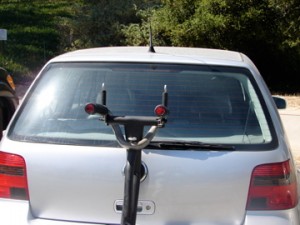
The best bike racks are the empty bike racks–meaning the owners have been able to take off for a ride!
And sometimes there’s no need for a rack at all…
Seems kind of obvious, eh! But when you left your bikes at home and are stuck in vehicle traffic, you may kick yourself for forgetting this option.
Having a bike rack on your car is probably one of the very wisest purchases you will ever make. You’ll save money on gas and parking and enjoy all the other benefits of cycling, far more often, when you have easy access to your bicycle because of that rack!
There are times when you don’t have time or energy to reach a destination by bike, yet can make the initial trip by car, then bicycle around. This is a great option when you like to shop, too–see shop-by-bike tips!
No more whining about not being able to find a parking spot for that car. It’s easy and fun. So do it! Trips three to five miles or shorter are faster on a bike than in a car.
Where to get a rack? And what type would I want? There are enough different types of bike racks that a separate post could be written about those! Talk with these Monterey County bicycle shops for guidance.
The dad and daughter below know
any distance of biking has multiple benefits over driving!
2. The Monterey-Salinas Transit system (MST)
Start with Bicycling Monterey tips about MST—Monterey-Salinas Transit: What to do when bike racks on buses are full, plus more MST tips, last updated May 14, 2024.
Also check out David M. Schmalz’s Nov 20, 2021 post in the Monterey County Weekly, “With proper planning, riding the bus in Monterey County is convenient, affordable and climate-friendly.”
For the most current and accurate MST information, including service changes—e.g., changes announced by MST on August 13, 2021—visit https://mst.org.
Below, learn more about MST and its helpful features. Among those is MST RealTime – a set of tools (text, phone, app, and maps) for real-time info about when the next bus will arrive.
MST support for people who bike includes that it has confirmed for accuracy all the MST tips provided in Bicycling Monterey’s “Bike-and-Ride” section. (Thanks, MST!)
Call MST (1-888-MST-BUS-1)
or visit www.mst.org
for updates and for the most accurate and detailed information.
Where’s the bicycle info on the MST site?
- Highlight the Rider’s Guide tab with your mouse, then How to Ride, then Transit Tips. Click on Transit Tips, then scroll down for “Bicycles on Buses” and “Bike Loading Instructions.”)
- Be sure to note MST’s bike size and other restrictions. (Have a “Big Dummy” cargo bike? Devian Gilbert shared these tips.)
- For more tips, see “How to use the bus-bike combo” below.
Keep an eye on MST every May for alerts that summer youth passes will go on sale. Why? Summer Youth GoPass makes it easier to get where you need to go, economically, by covering all your MST rides June 1 – Aug 31. The passes typically go on sale about the third week of May. For details, plus more tips for youth who bike-and-ride, see “18 or under, no car, no worries.”
Will the bus be on time?
- According to Monterey-Salinas Transit, “MST maintains a stellar on-time performance record that exceeds 90% of trips arriving within five minutes of their scheduled time.”
- As of May 13, 2019, MST states: “For RealTime bus arrival information, text ‘Next’ and your four-digit bus stop ID (example, ‘Next 9103’) to 25370, call 1-888-MST-BUS1 with your four-digit bus stop ID, download the free Transit App, or use Google Maps. Follow twitter.com/mst_bus for the latest service alerts. (Archived note: As announced September 30, 2016, “When is my bus going to arrive?” can now be answered via smartphone, tablet, or computer, thanks to MST’s new RealTime bus arrival information. MST RealTime – a set of tools—text, phone, app, and maps—for real-time info.)
- Unexpected delays or other service alerts have also been provided on MST’s Twitter feed – @MST_Bus. No need to have a Twitter account. (If you don’t see anything on @MST_Bus twitter feed, that’s because they may delete tweets when they are no longer relevant.) If you’d like the option of getting alerts as a text message to your mobile phone, see the MST Service Alerts page.
- Transit app introduced 3/31/17 “gives passengers real-time bus arrival information on their iPhone or Andriod device. The app shows next bus arrivals, locates their nearest bus stop, and allows the user to set alerts for preferred routes.”
- “When will the bus get here?” In their September 9, 2021 news release, https://mst.org/news_items/monterey-salinas-transit-mst-conducts-analysis-as-it-evaluates-transit-network-and-considers-re-design/), MST reminds about their Real Time info: For RealTime bus arrival information, text “Next” and your four-digit bus stop ID (example, “Next 9103”) to 25370, call 1‑888‑MST‑BUS1 with your four-digit bus stop ID, download the free Transit app, or use Google Maps. Follow MST on Twitter at www.twitter.com/mst_bus for the latest service alerts.
What’s new?
- Watch the MST site’s News section for new offerings and other service updates.
Bike lockers at MST’s Salinas transit center. Refer to the lockers info in Bicycling Monterey’s bicycle parking section for details, or contact MST.
Why consider the bus-bike option?
- There’s no added cost! The Monterey-Salinas Transit system transports bicycles free with a paying passenger.
- The bus goes just about everywhere–don’t hesitate to ask questions of their helpful phone attendants 1-888-MST-BUS-1. Ask them how to get to government offices, libraries, medical clinics and hospitals, historic sites, recreation/sightseeing, schools, shopping and employment, and other destinations.
- As mentioned earlier on this web page, if the unexpected occurs and you are using alternative transportation such as MST bus or your bicycle, be prepared with the Transportation Agency for Monterey County’s Emergency Ride Home program.https://www.tamcmonterey.org/emergency-ride-home. / https://mst.org/riders-guide/how-to-ride/emergency-ride /
- As of July 2019, all MST trolleys have bike racks (as do the large and small MST buses). Read about the new MST trolleys: https://mst.org/news_items/mst-replaces-iconic-monterey-trolleys-with-new-ones/
- See “Visitor Information” page for other helpful options.
- Monterey Jazz Line is an MST rapid transit bus line that also serves as a linear jazz museum. Free Wi-Fi at this line’s Sand City station. (See photos of this station at a celebration of Monterey Jazz Line with U.S. Transportation Secretary.)
- There are many beautiful places to bike in that you may not want to bike to. For many such places, the bus can take you (and your bike) there! Examples (check with MST and other resources referred to for any updates they may have):
- Toro Park, Salinas – a favorite for mountain bikers. Please “bike polite” on shared used trails. Refer to tips for responsible mountain biking in “Monterey County Teens Bike.”
- Andrew Molera, Big Sur (831/667-2315)—if MST service to Big Sur is restored. Yield to horses on the multi-use paths. (Click here re: biking in California’s state parks.)
- Point Lobos, south of Carmel – Note: you may bike the roads here, but not the trails.
MST Transit Connections: Connecting with other mass transit—buses, trains, planes.
CHECK WITH MST FOR UPDATES.
MST has connected with various transit systems in San Luis Obispo County, Santa Cruz County, Santa Clara County, San Mateo County, and San Francisco, East Bay, and Sacramento. See MST’s Transit Connections web page, http://mst.org/riders-guide/transit-connections/, to learn about MST’s connections with other transit systems—most or all of which, like MST, are happy to carry bicycles too. Note at the top of MST’s transit connections web page their suggestion about Google Transit, a tool for putting together mass transit trips.
How to use the bus-bike combo
- For Monterey-Salinas Transit system route list, system maps, and other details, visit the MST website or phone them at 1-888-MSTBUS1 (1-888-678-2871).
- MST’s website includes a “Quick Trip Planner” powered by Google; check it out on MST.org homepage.
- There is only one exception in the MST system, with regard to having bike racks: there are no bike racks on Rides/ADA buses. MST offers transportation in cooperation with the Americans with Disabilities Act (ADA) to MST customers with a disability that prevents them from using the MST regular fixed-route bus service. These buses do not accommodate bicycles. All other MST buses (large and small) and all MST trolleys do have bike racks!
- Bus-bike instructions on the MST website: Highlight the Rider’s Guide tab with your mouse, then How to Ride, then Transit Tips. Click on Transit Tips, then scroll down for “Bicycles on Buses” and “Bike Loading Instructions.” Included are specifics about bike height and weight restrictions, electric bikes, and more.
- Note that MST’s tips include “Remove child carriers, panniers and other luggage before bus arrives.” and “Always load from the curb side of the bus.”
- Don’t be afraid to immediately ask for help. Although drivers certainly are on schedule, the first time I used an MST bike rack it looked intimidating, as I’m not that mechanically minded. The driver cheerfully came down and showed me how to do it, and I was pleasantly surprised to learn how easy it is to load your bike onto an MST bike rack.
- You may also find it helpful to refer to page 18+ of this Sept 2011 PDF from MST (both English and Spanish instructions): http://www.mst.org/wp-content/media/MST-RG-9-11.pdf
- Important: when you reach your destination, leave by the front door. Ask the driver to wait while you unload your bicycle.
- Teach children good safety practices. Check out these tips from Ecology Action of Santa Cruz (our neighbors across the bay). Their tips are available in English and Spanish: Bicycle Safety Around Big Trucks and Buses
- Concerned if there will be enough space for your bikes?
- MST buses have two bike racks on the front of every bus.
- At the driver’s discretion, it’s sometimes possible to put two additional bikes in the area intended for securing wheelchairs. Please be kind to the driver if he or she declines to use the wheelchair area for bikes; drivers usually know their routes well and may anticipate a regular rider up ahead who needs that space for a wheelchair.
- What if there are more than 2-4 bikes? Actually, with both the large and small MST buses, when it is necessary to bring a bicycle aboard the bus (racks are full), the drivers of all the large MST buses have no problem with that, and most small MST bus drivers don’t either. (See more on the small MST buses in next section.) MST drivers simply direct the cyclist to keep a firm hold on their bicycle and to keep it out of the aisle. Reasonable requests, certainly!
How do MST bus drivers actually respond about transporting bicycles?
Very nicely! Here are some details, from a little test run I did in December 2009.
- I went out for a rainy day bike ride on two rainy afternoons. I wanted to doublecheck the responses from individual MST drivers about loading bicycles onto their buses, especially on rainy days, when tension might be higher. (Driving in rain can be so stressful.) I made a few trips around the Monterey transit center triangle plaza, speaking with individual drivers. Without exception, each driver I spoke with was pleasant and helpful about loading a bike onto their bus.
- The smaller MST buses are actually subcontracted out by MST to another company, MV Transportation. However, the drivers of those smaller buses too are helpful regarding bicycles on their buses. Although their official policy seems to be that they only put bikes on the racks of these smaller buses, drivers do have flexibility and most often allow buses inside, space permitting.
Where to board?
Wonder where the main transit centers are? MST’s “How to Ride” overview shows the various transit centers–Monterey Transit Plaza, Salinas Transit Center, Marina Transit Exchange, Sand City Station (formerly called Edgewater Transit Exchange), Watsonville Transit Center, and more–then gives info on determining which bus to take, etc.
Monterey Transit Plaza: Of course you can board the bus at many locations, but Monterey’s downtown transit center is at the Simoneau Plaza, a triangular plaza at the top of Alvarado Street, our “main street.” It’s only a short distance from the Monterey Public Library, with Internet access; and one short block from Monterey’s Main Post Office on Hartnell Street. The transit center is surrounded on its three sides by landmarks such as the Cooper-Molera historic adobe and the new Uptown Monterey shopping center; Old Capitol Books; and Ordway Pharmacy. (Note: Looking for MST’s clip-on flashing red lights, handy to help make a cyclist–or pedestrian–more visible at night? Ask for them at the MST Bus Stop Shop.)
Salinas Transit Center: Just off Main Street, and not far from the Amtrak train station, the National Steinbeck Center, the Steinbeck Public Library, the Post Office, and much more! Make use of tips on bicycling Salinas!
Carmel-by-the-Sea: The “transit center” is at Devendorf Park (little kids love the goldfish pond there), just across from the Carmel Plaza. Devendorf Park has a grassy lawn, benches, and a public restroom. This is a good place to unload bikes and get your bearings to launch out on biking Carmel-by-the-Sea.
Libraries:
An aside: Of course, local libraries are a great resource for travelers. The City of Monterey encourages bicycling as a transportation choice, and bicycle racks are right out front, as at other libraries in the county. Besides the City of Monterey’s library, Pacific Grove, and Seaside libraries are all within close biking distance of the bike/multi-use path. The Salinas library’s John Steinbeck branch is near the MST Salinas Transit Center. The Carmel library’s children’s branch is right across the street from the “transit center” of Devendorf Park.
3. Train Service
Note: The local bus system, Monterey-Salinas Transit (https://mst.org), has a Salinas Transit Center downtown, a short walk from the Amtrak Station.
Amtrak
Amtrak train serves Monterey County, with train service into Salinas and train-bus connections into Monterey as well. Check directly with Amtrak for their most up-to-date, accurate, and detailed information. 1-800-USA-Rail. On Twitter, @Amtrak.
-
The following Amtrak web page includes the Salinas Amtrak station’s days/hours and other info: https://www.amtrak.com/stations/sns.html
-
Amtrak’s “Special Items in Baggage” page https://www.amtrak.com/special-items includes the Coast Starlight train https://www.amtrak.com/routes/coast-starlight-train.html, which serves the Monterey County seat, Salinas. The “Special Items” page includes some info about bicycles and refers to the “Bring Your Bicycle Onboard” page https://www.amtrak.com/bring-your-bicycle-onboard
The League of American Bicyclists website has info of interest to people taking a bicycle on Amtrak. As of October 9, 2021, the League’s most recent post is the following one from September 13, 2017: https://www.bikeleague.org/content/amtrak-welcoming-bikes-trains
Packing tips
If you need to box your bike for the train, check out this video on packing your bicycle for Amtrak from the Path Less Pedaled cyclists Laura Crawford and Russ Roca.
Sage advice from a car-free local
One person experienced with using the Amtrak service to and from Monterey County from 1993 to 2011 is Devian Gilbert. Here are some general tips from Devian, current as of January 2011. For updates and any possible changes, check with Amtrak.
- In terms of Salinas, Devin’s 2011 tips indicated there was only one requirement to box a bike, and that was if using the Coast Starlight. Update 9/26/16 from Velo Club Monterey member Steve Blum: Amtrak now allows unboxed bikes to/from Salinas for a $20 fee, only between stations with baggage service. Amtrak buses are CA services, so bikes are always allowed for $0. Amtrak’s Coast Starlight train is federal, and there is a $20 fee for bikes—at limited stations; e.g., (a) San Luis Obispo to Los Angeles, bikes are $0 on Coast Starlight because that route runs by Surfliner rules. (b) From Salinas to San Luis Obispo (or Los Angeles), there is a $20 fee for bikes on Coast Starlight because that route runs by federal rules. In addition, Steve suggests that reservations are necessary. As of 9/26/16, he indicated that “Amtrak is allowing six bikes per train on the Coast Starlight (and other federal routes in California – the California Zephyr, Southwest Chief and Sunset Limited/Texas Eagle).” He suggests, “It’s a good idea to reserve ahead rather than wait until you get to the station.” As always, check with Amtrak for the most current and accurate information.
- All other Amtrak services out of Salinas are Amtrak “coach,” meaning Amtrak bus, and bicycles just go in the bus’s cargo hold. No box required.
- Putting your bike under an Amtrak bus is an awkward moment. While the goal is for Amtrak staff to do their best in accommodating a cyclist, this may not happen 100% of the time with an Amtrak bus.
- Devian bikes from his home on the Monterey Peninsula to Salinas. (Not able to bike that distance as Devian does? Consider using taking your bike aboard the MST bus; tips for bike-bus are also included on this web page.)
- Get on Amtrak bus to San Luis Obispo. (Have a “Big Dummy” cargo bike? Note Devian Gilbert’s instructions.)
- In San Luis, board the Pacific Surfliner train, where bicycles simply go into the baggage car. An Amtrak conductor just takes your bike and puts it in a rack. Your bike needs to be free of any bags, so if you are using panniers, they have to come off the bike. Board the train with the panniers in hand, as carry-on luggage.
- From San Luis, the Pacific Surfliner continues south all the way to San Diego. Enjoy the ride! And once you arrive, you’ll be so happy you have your bicycle with you to enjoy biking San Diego.
Ticket, please
When traveling by train in the state of Washington, Prudent Cyclist Will Vanlue of Portland wasn’t sure about ticket purchase requirements. In his case, Amtrak advised him his bike didn’t require an extra ticket, and they gave him a refund. Click here for Will’s story.
See Bicycling Monterey’s post “Traveling by train in Monterey County, and beyond: groundbreaking for new Salinas train station; “future commuter” train trip; more improvements ahead.”
4. Taxicabs:
- If you are traveling solo and misjudge whether you can reach your destination by nightfall (or if that grey sky just started pouring rain), consider calling a cab. Most local cab companies are happy to pick you and your bike up. (I know from personal experience! So far, I’ve only done this once. But Yellow Cab helpfully rescued me one night, and their number, 831/646-1234, is now stored in my cell phone.)
- I am unaware of any local cabs that have bike racks at present. But don’t be surprised if you find one soon; most cabbies I’ve spoken with think bike racks sound like a great idea.
- Most taxicab drivers are willing to load your bike into the (usually large) trunk of their car. Tip: carry a bungi cord with you if you anticipate the possibility of calling a cab, in case it’s needed to help keep the trunk lid “shut.”
5. Hotel shuttles:
 Staying at a Monterey County hotel? Ask the staff whether they can provide hotel shuttle service for you and your bicycle!
Staying at a Monterey County hotel? Ask the staff whether they can provide hotel shuttle service for you and your bicycle!
Perhaps you’re staying in a hotel that offers a shuttle service. Often these are large vans, and they’re sure to have lots of room for luggage–or bicycles. If you want to cycle when it might rain, simply ask your hotel’s concierge if their shuttle can be your rainy day back-up. Most often they will do everything possible to help their guests, and this reasonable request is likely to be met with a cheerful “Yes, we’ll be happy to provide that service.”
6. Airport Shuttle/Monterey Airbus:
 Nah, you can’t just show up at the Airbus and ask them to put your bike aboard for you.
Nah, you can’t just show up at the Airbus and ask them to put your bike aboard for you.
It’s different than taking the MST! For the Airbus, it needs to be boxed up.
Not flying in to the Monterey Airport? There is a reliable shuttle service from San Jose and San Francisco airports to Monterey County: the Monterey Airbus. Check their website for details and the most current info. As of April 10, 2012, stops include Monterey, Marina, and Prunedale Park n’ Ride.
During Sea Otter Classic week, many cyclists use this service and commented that there was an extra charge for transporting their bike. That’s true, because each passenger is allowed, without extra charge, one checked suitcase and one small carry-on. Additional oversized (62 linear inches) or overweight (50 pounds–the max drivers are required to lift) items will be accepted for an additional fee of $10, space permitting. (See bulleted tips below.)
Just in case you get a new Monterey Airbus driver unfamiliar with the company’s bicycle policy, who may accidentally try to charge you too much, you may want to bring a print-out of Monterey Airbus rates from their website. (One SOC visitor had boxed his bike smaller than a suitcase, and initially the driver erred and said the charge would be $35 for his boxed bike and $10 for his suitcase. After the traveler produced a print-out to clarify the rates for the driver, the correct fee was charged: the suitcase was complimentary, and the boxed bike was $10.)
Here are the tips on bringing your bike on the Airbus, provided by their staff, and confirmed April 10, 2012:
- Bicycles must be in a box. As with all luggage, label it with your name, address, phone.
- Book reservation in advance, due to bringing a box; that’s the way to ensure there will be space for your bike.
- If you reserve online, rather than by phone, be sure to note you’ll bring a box.
- That additional charge? A reasonable $10. Cheaper than renting a bike!
If you have a group of cyclists bringing bicycles together, consider the option of renting a private-service vehicle from the Monterey Airbus/Main Event Transportation company. 831-646-LIMO or 646-5466.
7. Monterey Regional Airport:
July 19, 2017 update from Alaska Airlines, which serves the Monterey Regional Airport: “Sports equipment now flies for $25 on Alaska Airlines,” and bicycles are among the sports equipment allowed. Refer to the Alaska Airlines post for details. Flying another airline? Ask them what their policy is.
Click here to go to Bicycling Monterey’s tips for patrons of the Monterey Regional Airport (formerly known as Monterey Peninsula Airport). There you’ll find info on:
Bike lockers at Monterey Regional Airport
Call ahead to reserve!
Photo courtesy of Amelia Poma and Jennifer Hickerson
8. Rental cars:
Below, Bobbi Kamil, with her folding bike
Bobbi and her husband travel with their bikes a lot! And when home, these Monterey residents still make use of their folding bikes–as Bobbi shows below, on a stop in Seaside.
Rental cars are perhaps the last frontier in expanding bike-and-ride options for cyclists in Monterey County, and elsewhere. Ask rental car companies to make bike racks available for their cars. Increased customer demand for this service will make it more likely you’ll find a bike rack available next time you rent a car.
Some rental car companies rent bike racks (e.g., Hertz: https://www.hertz.com/rentacar/productservice/index.jsp?targetPage=bicycle_racks.jsp).
Some travelers ship a portable rack ahead to their destination.
Old furniture blankets or other old blankets help protect both vehicle and bicycle from damage. Many Goodwill and other thrift stores in Monterey County will carry such items, inexpensively.
If using a portable bike rack, a stop at a hardware store (phone locally owned ones first, such as Best of Monterey County’s hardware store winners Forest Hill Ace in Pacific Grove and Coast Hardware in PG) to pick up material used to protect pipes may be worthwhile to keep a rack from scratching a vehicle’s paint.
9. Sailboats:
Sailboats + folding bikes = happy travelers!
If you are fortunate enough to own a sailboat, or otherwise have the opportunity to be traveling by sailboat, you know that limited capacity for bringing things aboard means that the small size of folding bicycles make them a great bike-and-ride option.
How to choose a folding bike? One of many resources for your research: https://momentummag.com/a-guide-to-buying-your-first-folding-bike/
Below, folding bikes of people visiting the Monterey Bay in October 2022.
* * * * *
Drive? You gotta be kidding. We’re parking it! These buses brought us here, but we came to bike.
* * * * *
If you found info on this site valuable
Please consider making a contribution to help maintain and expand these resources.
Short link to this page: http://bit.ly/BikeAndRide

